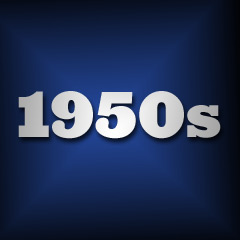
|
![]()
Greatest Films of the 1950s
1950 | 1951 | 1952 | 1953 | 1954 | 1955 | 1956 | 1957 | 1958 | 1959
Title Screen Film Genre(s), Title, Year, (Country), Length, Director, Description 

Ace in the Hole (1951) (aka The Big Carnival), 111 minutes, D: Billy Wilder
Director/co-writer Billy Wilder's uncompromising, and harsh noirish commentary was a scathing attack on the sensationalizing and ruthless tabloid mass media. It was the 50's version of the 70's Network (1976) and of the 80's Broadcast News (1987). Charles 'Chuck' Tatum (Kirk Douglas) - a belligerent, self-obsessed, unscrupulous big-city newspaper reporter found himself working for the Albuquerque Sun-Bulletin (with its hand-embroidered motto "Tell the Truth"). He had been fired from previous jobs for alleged libel, cheating with the boss' wife, hot-headedness and drunkenness. Contemptuous of New Mexico and utterly frustrated after a year there, he missed New York after being stuck in New Mexico for a year: ("...Too much outdoors. Give me those eight spindly trees in front of Rockefeller Center any day. That's enough outdoors for me...). To stir up excitement and readership and to jump-start his career, he exploitatively stage-managed an "ace in the hole" media-frenzied story - an orchestrated operation to rescue good-hearted Leo Minosa (Richard Benedict), the adult son of a trading post owner, trapped by a cave-in of rocks 250 feet inside an ancient, haunted Indian cliff dwelling (Mountain of the Seven Vultures) where he was looting it of artifacts in the remote town of Escudero (three hour's drive from Albuquerque). He perpetuated his sleazy, hustling scheme with Leo's long-suffering, jaded, and unhappy femme fatale wife Lorraine (Jan Sterling) who had a five-year unfulfilled marriage to Leo. The opportunistic young woman first considered running off, but was hustled by Tatum to remain when he suggested that there would be monetary rewards for staying and pretending to be a grieving wife. She was easily persuaded by the promise of revenue from gathering throngs to remain with her ailing husband. Tatum also manipulated the local corrupt Sheriff Gus Kretzer (Ray Teal) up for re-election to help in his scheme. He was able to delay rescue efforts that would have taken only about 12-16 hours (by simply shoring up the mine and pulling Leo out), but instead convinced the crew to drill from above (a 6-day job). In the meantime, the rescue site became a frenzied tourist attraction - a literal circus (S & M) amusement park and carnival, and a camp ground, with rising admission prices and everyone taking lucrative advantage of the situation. Ultimately, last rites were administered by a priest to pneumonia-stricken Leo after 6 days of being unnecessarily trapped in the cave-in. Afterwards, Tatum delivered a memorable speech to the crowds to go home after Leo's death. In the shocking conclusion, the bleeding, defeated journalist Tatum collapsed at the feet of his editor-in-chief Mr. Jacob Q. Boot (Porter Hall).



The African Queen (1951), 105 minutes, D: John Huston
Based on the 1935 novel by C.S. Forester, the wonderful combination of Hepburn and Bogie makes this a thoroughly enjoyable blend of comedy and adventure. Forester's story, Bogey's Oscar®-winning performance, 'odd-couple' chemistry, and an exotic locale combine for classic adventure/romance. The boozing, smoking, cussing captain of a tramp steamer, Charlie Allnut (Humphrey Bogart), saves prim, sober, and proper missionary Rose Sayer (Katharine Hepburn), "a crazy psalm-singing skinny old maid," after her brother (Robert Morley) is assaulted by a German soldier at the beginning of World War I in German East Africa, and dies from insanity. After many quarrels, they survive a treacherous African river journey on a rattle-trap steamer, shoot the rapids, struggle with mosquitos and blood-sucking leeches, and set sail on the Ulonga-Bora in order to sabotage The Louisa, a German warship.

Alice in Wonderland (1951), 75 minutes, D: Disney Studio
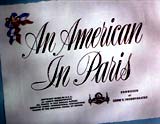


An American in Paris (1951), 102 minutes, D: Vincente Minnelli
One of the great 50s screen musicals and a Best Picture-winner, colorfully enhanced by the grace and athleticism of Gene Kelly and direction by Vincente Minnelli. Jerry Mulligan (Gene Kelly), a young American G.I., lingers in Paris after World War II to study art and painting. He wants to live the life of the great painters -- in a Montmartre garret, starving for his art. When a rich, romance-minded American gallery owner (Nina Foch) offers to support him, he agrees -- even if the bargain means joining the benefactress' entourage of lovers. Then he meets Lise (Leslie Caron), a young, exquisite French mademoiselle, and instantly falls in love. Unfortunately, she's already engaged to marry her benefactor, music hall star Henri Baurel (Georges Guetary), an older man who saved her from the Nazis. But when Henri discovers that she cares for someone else, he gracefully exits, leaving the young couple to find love together. The film debut for French actress/dancer Leslie Caron, who was discovered by Gene Kelly. With sumptuous sets, charming dance sequences, George and Ira Gershwin's memorable melodies, and a seventeen-minute, avant-garde ballet choreographed by Kelly - with backdrops representing various impressionistic artists.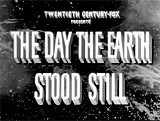

The Day the Earth Stood Still (1951), 92 minutes, D: Robert Wise
One of the seminal science fiction films of motion picture history, it is based on Edmund H. North's adaptation of the short story "Farewell to the Master" by Harry Bates. Much like the "drive in movies" of the 1950's, such as The War of the Worlds (1953), Forbidden Planet (1956), and Invasion of the Body Snatchers (1956), this influential, fantasy sci-fi film featured state-of-the-art visual effects and salient social commentary on the Cold War and warfare. The film not only examined wider issues of politics and society, but also human emotions and frailties. This cautionary science fiction parable begins with the landing of a spacecraft on Washington DC's Ellipse (President's Park). A benevolent, interplanetary alien in humanoid form, Klaatu (Michael Rennie) brings a message of good-will and peace, but he is shot by a nervous soldier. His massive robotic companion Gort (Lock Martin) vaporizes the offensive weapons, and afterwards, Klaatu is hospitalized. Then, he causes a panic when he demands to speak to all of the representatives of Earth's governments. He escapes and goes into hiding posing as an Earthling named Carpenter while residing with a human family (single mother/widow Helen (Patricia Neal) and her son Bobby (Billy Gray)) and others in a boarding house, in order to observe their lives, and meanwhile makes an attempt to establish contact with Earth's leading scientist Dr. Bernhardt (Sam Jaffe). Klaatu's demonstration of power over the industrial complex -- by stopping power everywhere for half an hour -- ends up tragically. One of the most famous phrases in science fiction history is recited by Helen to stop Gort's rampage when Klaatu is killed: "Gort, Klaatu barada nikto." The film ends with the alien visitor's resurrection and a warning-proclamation. With a memorable score by Bernard Herrmann.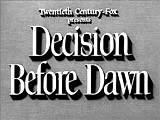

Decision Before Dawn (1951), 119 minutes, D: Anatole Litvak

Diary of a Country Priest (1951, Fr.) (aka Journal D'un Curé de Campagne), 95/115 minutes, D: Robert Bresson




The Lavender Hill Mob (1951, UK), 81 minutes, D: Charles Crichton
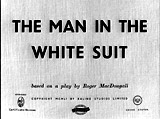



The Man in the White Suit (1951, UK), 85 minutes, D: Alexander Mackendrick



Miracle in Milan (1951, It.) (aka Miracolo a Milano), 100 minutes, D: Vittorio De Sica





Pandora and the Flying Dutchman (1951, UK), 122 minutes, D: Albert Lewin



A Place in the Sun (1951), 123 minutes, D: George Stevens
A star-crossed melodramatic romance (and social drama), based on Theodore Dreiser's 1925 novel "An American Tragedy." Low-born, ambitious George Eastman (Montgomery Clift) hitched a ride to his distant Uncle Charles Eastman's (Herbert Heyes) place, where he was given an assembly-line bathing-suit factory job. The poor boy was entranced and infatuated by the snobbish, beautiful, well-bred rich socialite Angela Vickers (Elizabeth Taylor) and they fell in starry-eyed love. He also dated and impregnated poor, lower-class co-worker Alice Tripp (Shelley Winters), after which a doctor refused to terminate her unwanted pregnancy (the term abortion was not used). Using blackmail, she also threatened to reveal their relationship and pregnancy, and even mentioned committing suicide. On Labor Day weekend at the Vickers' lakeside home, Alice arrived to confront George, and insisted that they go to the county clerk's office to get married - but it was closed for the holiday. During a rowboat ride with Alice on Loon Lake that dark night, George contemplated, planned and willed (if not actually committed) the murder of his fiancee, by overturning the boat and letting her drown. Then, in a twist of fate, she accidentally fell in when the boat capsized, and she drowned, and he was unable (or unwilling) to save her. George faced murder charges and went to trial. He intended to murder Alice, but there were no witnesses that he actually did. There was only strong circumstantial evidence against him. The relentless District Attorney R. Frank Marlowe (Raymond Burr, TV's future Perry Mason) devastated George on the stand. He even re-enacted the rowboat death in the courtroom, while George failed to credibly answer questions and help to reconstruct the drowning. The most dramatic moment was when Marlowe struck the oar across the boat, implying that George had struck Alice and caused her to fall into the water. George was convicted - and fell from his 'place in the sun' when executed (by the electric chair).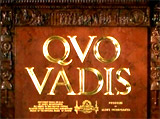


Quo Vadis (1951), 171 minutes, D: Mervyn LeRoy




Scrooge (1951, UK) (aka A Christmas Carol), 86 minutes, D: Brian Desmond Hurst
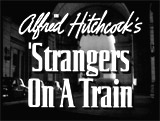


Strangers on a Train (1951), 101 minutes, D: Alfred Hitchcock
Another of Hitchcock's great suspense thrillers - co-scripted by Raymond Chandler and based on the novel by Patricia Highsmith. During a 'chance' meeting on a train enroute from Washington DC (a cleverly-choreographed sequence in which the two sets of the strangers' shoes are highlighted), rich psychopathic playboy Bruno Antony (Robert Walker) explains his macabre, morbid theory of the perfect murder - an exchange or swap of murders and victims - to professional champion tennis player Guy Haines (Farley Granger). Bruno diabolically proposes murdering Guy's clinging, stifling wife Miriam (Laura Elliot) - since Guy wants to marry US Senator's daughter Anne Morton (Ruth Roman) - in exchange for Guy murdering Bruno's spiteful father (Jonathan Hale) and his acquisition of an inheritance, without any trace of clues. Haines dismisses the preposterous idea until Anthony kills his wife Miriam by strangulation at an amusement park and he is expected to fulfill his part of the bargain - with threat of blackmail. With a few great set pieces, including the amusement park stalking, the cocktail party scene of how to commit a murder, the tennis match cross-cut with the sewer grating scene, and the out-of-control merry-go-round in the finale when Guy was finally cleared of the murder.

A Streetcar Named Desire (1951), 125 minutes, D: Elia Kazan
The powerful, frank dramatic adaptation of Tennessee Williams' Pulitzer Prize-winning play, based upon Oscar Saul's adaptation. The story of two sisters: a neurotic, sensitive southern belle Blanche DuBois (Vivien Leigh) who visits and remains with her sister (Kim Hunter) and her animalistic, earthy and vulgar brother-in-law Stanley Kowalski (Marlon Brando) in a down-and-out New Orleans project in the French Quarter. Mitch (Karl Malden), one of Stanley's buddies takes an interest in Blanche until Stanley strips and ultimately reveals the secrets of her embarrassing, lurid past. After being 'raped' by Stanley in a heavily-censored and edited sequence, the vestiges of her shattered self are led away to a mental institution.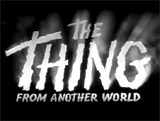



The Thing (From Another World) (1951), 87 minutes, D: Christian Nyby
An influential and taut horror and science-fiction B-film hybrid based on John W. Campbell's 1938 story Who Goes There? This alien invasion film was producer Howard Hawks' sole science-fiction effort. A group of isolated scientists led by military pilot Captain Patrick Hendry (Kenneth Tobey) and lead researcher Dr. Carrington (Robert Cornthwaite) are stationed in a remote Arctic base. They discover a flying saucer UFO buried deep in the tundra, along with an eight-foot alien body (James Arness) in a block of ice. After removing the frozen spaceman from the craft and bringing it back to their research station headquarters, the Thing creature (a chlorophyll-based humanoid) accidentally thaws and escapes, and proceeds to kill the sled dogs and hunt down the scientists themselves for their blood. The film effectively focuses on character interaction, with natural and rapid-fire dialogue, appropriate scientific jargon, and a strong-willed female character named Nikki Nicholson (Margaret Sheridan). The three most memorable moments are the discovery of the shape of the spacecraft, the scene of the alien set ablaze with kerosene, and the final warning/bulletin radioed by reporter Ned "Scotty" Scott (Douglas Spencer) from the North Pole: "...Watch the skies, everywhere! Keep looking, keep watching the skies!"